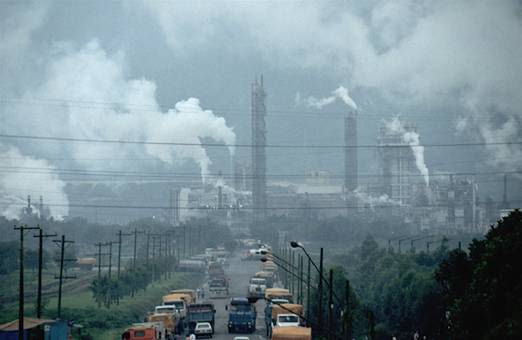
The system built to manage Russia’s nuclear legacy is crumbling, our new report shows
Our op-ed originally appeared in The Moscow Times. For more than three decades, Russia has been burdened with the remains of the Soviet ...
News

Publish date: January 29, 2015
News
MURMANSK – Rinat Gizatulin, Russia’s Deputy Minister of Natural Resources and the Environment, has demanded that Norilsk Nickel – the world’s biggest nickel producer and one of its most polluting industries – undertake comprehensive measures to bring its vast empire into line with environmental law.
The demands specifically target the Zapolyarny subsidiary of the company, which is based the northern Siberian city of Norilsk – routinely ranked by numerous studies as one of the most polluted places on earth.
Life expectancy among Norilsk’s 170,000 residents is 10 years shy of Russia’s average. They suffer high rates of cancer, lung disease, blood and skin disorders. Those in Norilsk who work at the local industry endure pollution, heat, and noise, and have to use masks or breathing tubes connected to oxygen tanks to draw fresh air on the job. In return, they get to retire at 45.

In the meantime, weekend escapes to the countryside are futile: Concentrations of sulfur dioxide in the air is so high that vegetation in an almost 30 kilometer radius is dead. Dead, too, is the Russian birthright of mushroom picking: Norilsk’s residents are forbidden to do it because toxicity levels in the edible fungus are too high.
In May 2014, Norilsk Nickel signed a targeted investment program to hasten the closure of its aged nickel production facilities that are deemed beyond modernization.
The agreement was signed among the industrial giant and Russia’s Ministry of Economic Development, the Ministry of Industry, the Ministry of Natural Resources, the administration of the Krasnoyarsk region where Norilsk Nickel is located, and the administration of its host town Norilsk.
Under this agreement, Norilsk Nickel is supposed to be rapidly implementing a project aimed at improving its environmental performance and modernizing production by 2016 instead of 2018. This is contingent on a government agreement to abolish export duties on unalloyed nickel, copper cathodes and sections of cathodes, being made effective as of last year instead of 2016.
The company guaranteed that the entire financial effect of nullifying export duties early would accelerate the closure of derelict nickel production units in Norilsk and help the company address related environmental and social projects.
It was assumed that halting the nickel factory’s production would cease emissions of sulfur dioxide, nickel oxide, copper oxide, lead and a number of inorganic compounds.
However, according to Gizatulin, Russia’s Federal Service for Natural Resource Usage Oversight – known as Rosprirondador – discovered a number of significant violations of Russian environmental law during inspections of Norilsk Nickel’s operations, as well as a lack of efforts to reduce their negative effects on the environment.
Specifically, Rosprirodnador reported higher than acceptable emissions by the Norilsk facilities of sulfur dioxide –the chief component of harmful emissions observed at the company’s daugher facilities in the Murmansk Region.
According a posting on the Ministry of Natural Resources website (in Russian), Norilsk’s nickel factories exceeded emissions norms by 44 times. Its copper plant was pushing out emissions at 14 times the legal limit. And its Nadezhda smelting plant, emitted 8 times above regulations.
The site also said the ministry observed discharges of toxic waste substances into water bodies by the company’s Zapolyarny facility.
“The company produce the Ministry of Natural Resources and Environment and Rosprirodnadzor’s targets for emissions reductions in the framework of closing the nickel plant, which violates one of the points of the Agreement on Cooperation signed in May 2014,” Gizatulin wrote on the Ministry website. “Aside from this, 2014’s third quarter report on fulfillment of the Comprehensive Program [for reducing emissions] testifies to increased atmospheric emissions by the company as a whole.”
According to Amirkhan Amikhanov, Rosprirodnadzor’s acting director, these facts where brought to the attention of Norilsk Nickel’s management with the demand that it undertake to reduce industrial activities that harm the environment.
“The regional authorities of Rosprirodnadzor are instructed in all cases of violations to bring the perpetrators to administrative responsibility in accordance with the requirements of legislation,” Amikhanov said.
A recommendation was made to Norilsk Nickel to send the Ministry of Natural Resources a scheduled plan to create an inventory of the company’s emissions sources, and to develop and approve new standards for maximum permissible emissions due to changes in technology by February 6.
The nickel factory at Norilsk has operated since 1942 and produces 120,000 tons of nickel annually. Last year, the company closed it in accord with its modernization plan, a loss that’s expected to be compensated by the renovated Nadezhda smelting works.
The closure of the nickel factory in May of last year was estimated to cost some $300 to $500 million by Pavel Fyodorov, Norilsk Nickel’s deputy director told RBK news (in Russian). The company held negotiations with the government for joint financing. Fyodorov estimated the economic effect of the modernization project to be some $450 million a year, and added that the program would improve Norilsk’s dismal environmental circumstances.
“Bellona has for years pointed out the problems associated with the insufficient tempo of Norilsk Nickel’s modernization programs, especially its daughter companies at the Kola Mining and Metallurgy Complex [KMMC] here on the Kola Peninsula” said Anna Kireeva of Bellona Murmansk. “But demands by environmentalists to reduce harmful emissions, particularly sulfur dioxide, have been completely ignored.”
She noted that various inspections carried out by Rosprirodnadzor of the KMMC have failed to yield results showing levels of pollution that have numerous times been revealed by other Russian scientific agencies.
In recent weeks, Ruslan Tischenko, director of the Murmansk Region’s branch of Rosprirodnadzor, was arrested on suspicion of taking bribes to give some of the regions most polluting industries a pass on their illegally high emissions, and Kireeva doesn’t hold much hope that appropriate punishment will be brought against Norilsk Nickel’s local holdings anytime soon.
“The authorities ignore the problem, and Norilsk Nickel’s companies themselves only report on their successes, which, in the end, do nothing to improve the environmental situation in the regions where they pollute,” she said.
“Bellona hopes that the Ministry of Natural Resources and the Environment will force Norilsk Nikel to live up to its obligations,” Kireeva said.

Our op-ed originally appeared in The Moscow Times. For more than three decades, Russia has been burdened with the remains of the Soviet ...

The United Nation’s COP30 global climate negotiations in Belém, Brazil ended this weekend with a watered-down resolution that failed to halt deforest...

For more than a week now — beginning September 23 — the Zaporizhzhia Nuclear Power Plant (ZNPP) has remained disconnected from Ukraine’s national pow...

Bellona has taken part in preparing the The World Nuclear Industry Status Report 2025 and will participate in the report’s global launch in Rome on September 22nd.